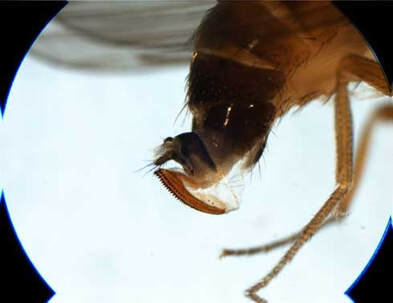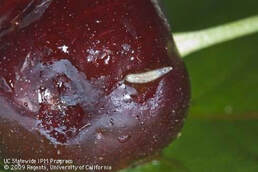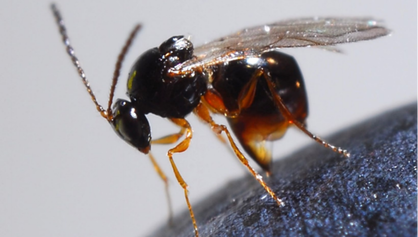 Fig. 1. SWD Large and serrated ovipositor (photo by Martin Hauser) Fig. 1. SWD Large and serrated ovipositor (photo by Martin Hauser) written by: Elizabeth Dabek, MS student, Hooks and Shrewsbury lab & Serhat Solmaz, MS student, vanEngelsdorp Lab The Spotted-wing Drosophila (SWD) is an invasive pest native to Southeast Asia. Since it was first detected in 2008 in California, the fly has rapidly become widespread throughout North America. Unlike other common drosophila species breeding on rotting fruits, SWD female has a large and serrated ovipositor (Fig. 1) that enables it to lay eggs inside ripe and fresh fruits. As the fruit ripens, often after harvest, damage caused by SWD (dimples and craters on the skin of the fruit) becomes visible (Fig. 2). SWD is highly polyphagous; being able to oviposit and/or reproduce in various cultivated and wild fruits. Its fast development and high reproductive potential can lead to explosive population increases and significant economic losses to crops. Economic losses from SWD in the western US for raspberries, blackberries, blueberries, strawberries, and cherries are estimated to be up to $500 million annually1. Current control programs rely heavily on insecticides that target adult flies in commercial crops. Because non-crop habitats can act as a reservoir for the fly’s reinvasion into treated crops, area-wide IPM strategies such as biological control that reduce population densities at the landscape level need to be developed for such a highly mobile and polyphagous pest.  Fig. 2. SWD larvae on damaged cherry (Photo by Larry L. Strand) Fig. 2. SWD larvae on damaged cherry (Photo by Larry L. Strand) Biological control involves the use of co-evolved natural enemies to target a pest insect. The use of biological control is long known to be safe, cost effective, and environmentally sustainable if the correct testing is done. Parasitoids are commonly used as biological control agents and are insects in the order Hymenoptera. They are related to bees, wasps, and ants. The genus Drosophila, which is what the SWD is in, has over 50 parasitoids alone! Dr. Xingeng Wang, currently a Research Entomologist with the USDA-ARS Beneficial Insects Introduction Research Unit in Newark, Delaware, participated in the research (a collaborative project led by Dr. Kent Daane, University of California Berkeley, and Dr. Kim Hoelmer, USDA-ARS, Newark) to help find effective parasitoids for the biological control of this adverse pest while he worked previously as an Associate Specialist (with Dr. Daane) at the University of California Berkeley. Dr. Wang et al. (unpublished) first conducted surveys in California to find what resident parasitoids are already attacking this invasive pest. They sampled over 5000 fruits of various plants and recovered about 1200 individual parasitoids. The parasitoids belong to two common species attacking Drosophila larvae and another two common species attacking Drosophila pupae. These larval-attacking parasitoids were recovered from other Drosophilids (not SWD) because they were found to unable to develop and kill the SWD host possibly due to the fly’s immune resistance (SWD larvae are able to defend themselves by surrounding the parasitoid egg with blood cells that eventually melanize and kill the parasitoid egg through asphyxiation). Only the two pupal parasitoids were found to readily attack and develop from SWD. However, these two pupal parasitoids are not specific to SWD and their impacts on SWD was generally low (< 10% SWD parasitism rate). Because of the low parasitism by resident parasitoids and especially the lack of larval-attacking parasitoids, Dr. Wang and other scientists (see references 2-3) traveled to part of the native range of SWD, China and Korea, to look for more effective and host-specific parasitoids. In Asia, they have discovered at least 13 larval parasitoid species, with mean parasitism rates as high as 19% in South Korea and 30% in China2-3. Due to the promising higher rates of parasitism, several candidate larval parasitoids have been imported into the University of California Berkeley and USDA ARS Newark quarantine facilities for systematic evaluations on their biology and efficiency against SWD, host specificity, climate adaptability as well as potential interspecific interactions (competition) among different parasitoids. For example, Dr. Wang et al. (2019a,b) have compared the fecundity and host stage preference, and examined potential interspecific competition among three most promising Asian larval parasitoids, among other factors tested4-5.  Fig. 3. Ganaspis brasiliensis, one specialized larval SWD parasitoid (Photo by Kent Daane) Fig. 3. Ganaspis brasiliensis, one specialized larval SWD parasitoid (Photo by Kent Daane) Entomologists and conservationists alike are looking to find effective biological control without disrupting the current healthy ecosystems in place. It is thus important to not only look at the efficiency of a candidate parasitoid but also its safety to be released with regard to the risk to non-target species. To determine whether these Asian larval SWD parasitoids would have an effect on native drosophila species from regions where they would be released, 22 non-target Drosophila species collected in various US states were tested. Along with these, a species from Japan and another from Samoa were also tested as close representatives of rare and endangered Hawaiian Drosophilae. Based on these tests, currently they have selected the most host-specific parasitoid Ganaspis brasiliensis (Fig. 3) for approval of field release. Once approved, this parasitoid will be released preferably into non-crop plants to reduce the source SWD populations. Also, these resident pupal parasitoids, that have already adapted to local ecological conditions and can readily attack SWD, may be manipulated either through conservation or augmentation to contribute to SWD suppression. References
https://twitter.com/lizzydabek?lang=en Serhat Solmaz is a MS student in the vanEngelsdorp Lab studying the effects of Nosema cerenae on honey bee pathophysiology at the University of Maryland. Comments are closed.
|
Categories
All
Archives
June 2024
|
Department of Entomology
University of Maryland
4112 Plant Sciences Building
College Park, MD 20742-4454
USA
Telephone: 301.405.3911
Fax: 301.314.9290
University of Maryland
4112 Plant Sciences Building
College Park, MD 20742-4454
USA
Telephone: 301.405.3911
Fax: 301.314.9290

 RSS Feed
RSS Feed




